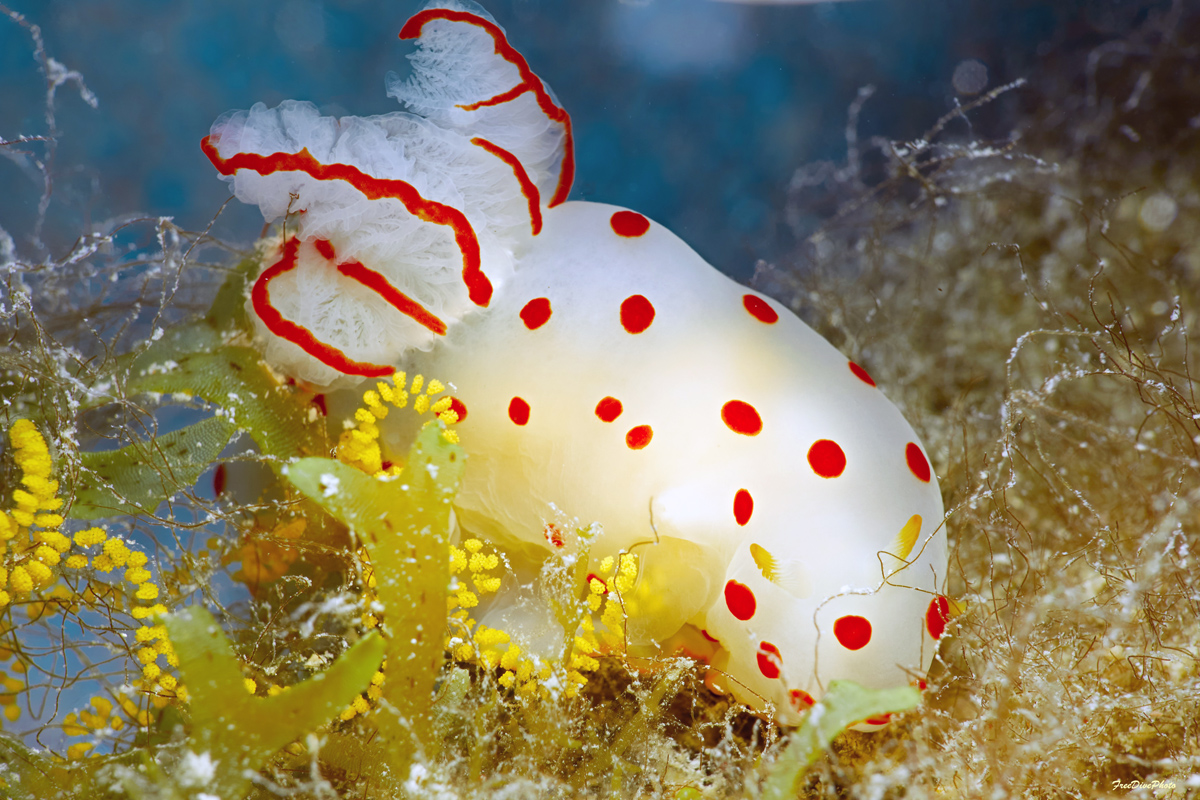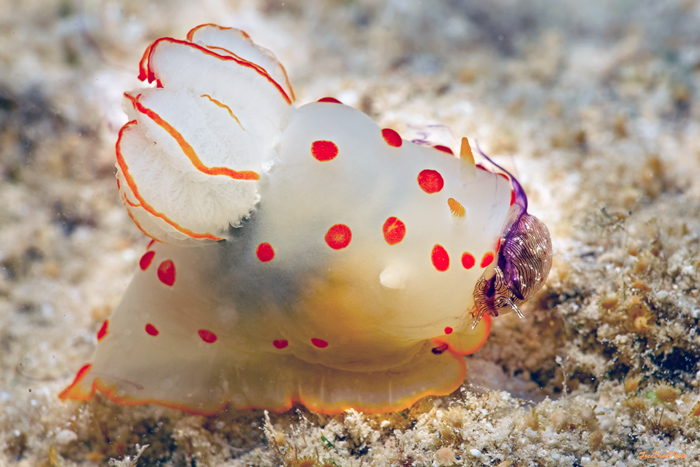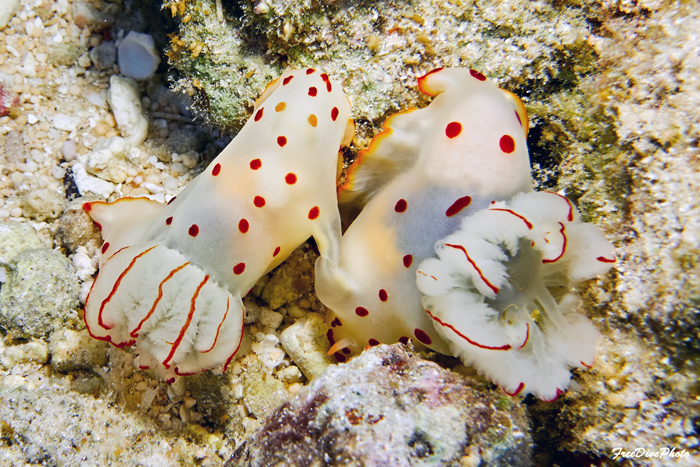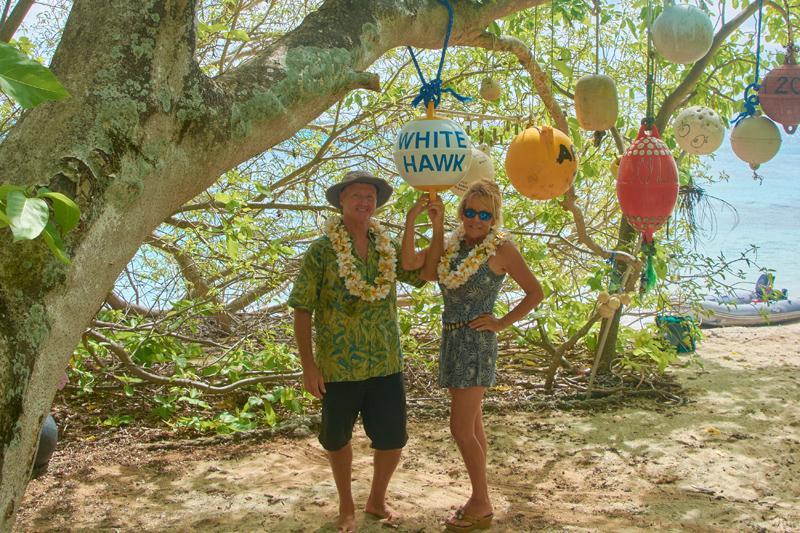 |
Image courtesy of John and Lynette Flynn
Majuro atoll in the Marshall Islands

|
Gymnodoris ceylonica (Kelaart, 1858) Well look what just came in from the citizen scientists John and Lynette Flynn in the Marshall Islands: "We recently observed a mass aggregation of Gymnodoris ceylonica which we estimate numbered over a thousand individuals and lasted several days. The high numbers and density of the animals presented us with opportunities to photograph mating, egg laying and feeding behaviors. And of course, the defense behavior of the little Sea Hare, Stylocheilus striatus secreting its purple fluid while it is being consumed by the G. ceylonica." Their photos pretty much tell the whole story. Gymnodoris ceylonica is large, up to 120mm in length, and is probably the best known of all the Gymnodorid's 60 of the 90 known species being undescribed. Most active at night, a mass aggregation like what John and Lynette observed, suggests that they were feeding on more than just Stylocheilus striatus. Gymnodoris ceylonica is known to be a cannibalistic, feeder, attacking their mates after copulation. Even more bizarre, on occasions, partners attempt to swallow each other while still mating. The larger of the two usually prevails consuming the reproductive organ last. With their red spots and bright yellow eggs, this species is certainly aposematic.
|
I put together a short video depicting Gymnodoris ceylonica behavior from a trip taken to the Komodos area back in 2015! The file is about 58 megs and in 720p Mp4 so if your bandwidth is limited, it may be a long download. The file can be downloaded and seen from a Hightail link ! This link expires Sept. 13th 2021!
Dave Behrens
Sammamish, WA 98074
Sept., 2021
Send Dave email at davidwbehrens@gmail.com

|
John and Lynette Flynn at the "clubhouse" of the Rongerik Yacht Club.
Rongerik is an uninhabited atoll in the Marshall Islands and to join the club you have to find some debris on the shore,
put your boat name on it, and hang it in the open air clubhouse.

We are John & Lynette Flynn, full time live-aboard cruisers and free-dive photographers who sailed our 46' boat "White Hawk" out of San Diego in 2014 and have been cruising the Pacific ever since. We are currently "stuck" in the Marshall Islands due to COVID border closures, but we have been enjoying our time here hunting Opisthobranchs in shallow water from 0.5 to 5 meters. We are currently shooting with Sony RX100V's in Nauticam housings with CMC-1 wet lenses, SOLA Video Pro lights, and a Sea & Sea YS-D3 strobe. Last year we photographed 51 species of Opisthobranch at Rongelap Atoll, and we are currently at over 100 species of Opisthobranch photographed at Majuro Atoll, including our first-ever discovery of a previously unknown species, a new Unidentia. We still shoot other animals but we are now full-fledged "nudiholics." Our motto is: "If you don't go - you don't know. If you don't look - you don't see."
Send John and Lynette mail at svwhitehawk@yahoo.com |

Attention all you Sluggers, and you know who you are! The NSSI 2nd edition is now available in ebook PDF and book form . The hard back version will become available Nov. 1st. Both will cost $65 (individually). You will need to jump through a few hoops to get the electronic version as pdf distribution is protected by Adobe ID!! Please read the following to enable reading your electronic purchase! This new 2nd Edition is updated and reorganized, including 185 new species. Among other features, the new edition includes additional photographs of species, an identification key, and an up-to-date classification reflecting the latest evolutionary relationships. The Indo-Pacific represents the largest expanse of tropical ocean in the world, stretching from the Indian Ocean coast of southern Africa and the Red Sea to the central Pacific of the Hawaiian Islands, Easter Island and the Marquesas. This region supports the most diverse marine fauna of any place in the world for most groups of marine organisms. The nudibranchs and sea slugs are no exception to this rule; there are about 3,000 described species of these organisms in the world and at least 40% of these have been found exclusively in the Indo-Pacific tropics. This book illustrates 2,138 Indo-Pacific nudibranchs and sea slugs, including many undescribed species.
|

|
